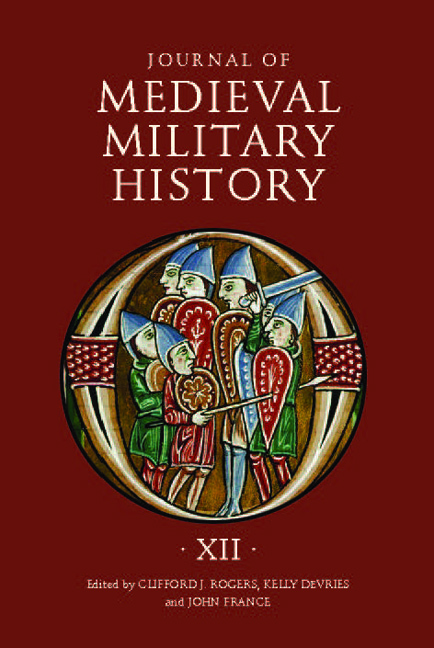Book contents
- Frontmatter
- Contents
- List of Illustrations and Map
- 1 Some Observations Regarding Barbarian Military Demography: Geiseric's Census of 429 and Its Implications
- 2 War Words and Battle Spears: The kesja and kesjulag in Old Norse Literature
- 3 The Political and Military Agency of Ecclesiastical Leaders in Anglo-Norman England: 1066–1154
- 4 Couched Lance and Mounted Shock Combat in the East: The Georgian Experience
- 5 The Battle of Arsur: A Short-Lived Victory
- 6 Prelude to Kephissos (1311): An Analysis of the Battle of Apros (1305)
- 7 Horse Restoration (Restaurum Equorum) in the Army of Henry of Grosmont, 1345: A Benefit of Military Service in the Hundred Years' War
- 8 The Indenture between Edward III and the Black Prince for the Prince's Expedition to Gascony, 10 July 1355
- 9 Investigating the Socio-Economic Origins of English Archers in the Second Half of the Fourteenth Century
- 10 War and the Great Schism: Military Factors Determining Allegiances in Iberai
- List of Contributors
- Journal of Medieval Military History 1477–545X
5 - The Battle of Arsur: A Short-Lived Victory
Published online by Cambridge University Press: 05 November 2014
- Frontmatter
- Contents
- List of Illustrations and Map
- 1 Some Observations Regarding Barbarian Military Demography: Geiseric's Census of 429 and Its Implications
- 2 War Words and Battle Spears: The kesja and kesjulag in Old Norse Literature
- 3 The Political and Military Agency of Ecclesiastical Leaders in Anglo-Norman England: 1066–1154
- 4 Couched Lance and Mounted Shock Combat in the East: The Georgian Experience
- 5 The Battle of Arsur: A Short-Lived Victory
- 6 Prelude to Kephissos (1311): An Analysis of the Battle of Apros (1305)
- 7 Horse Restoration (Restaurum Equorum) in the Army of Henry of Grosmont, 1345: A Benefit of Military Service in the Hundred Years' War
- 8 The Indenture between Edward III and the Black Prince for the Prince's Expedition to Gascony, 10 July 1355
- 9 Investigating the Socio-Economic Origins of English Archers in the Second Half of the Fourteenth Century
- 10 War and the Great Schism: Military Factors Determining Allegiances in Iberai
- List of Contributors
- Journal of Medieval Military History 1477–545X
Summary
Introduction
On the twenty-second of August, 1191, the Crusader army led by King Richard Lionheart left Acre. More than two weeks later and about 100 kilometers south of Acre, on the seventh of September, the Crusader and Muslim armies clashed in the Forest of Arsur.
I would like to suggest that the battle was practically inevitable because both sides had good reasons to seek a decisive encounter. The Lionheart could not conquer Jerusalem as long as Saladin's army was in the coastal plain, whereas Saladin wanted to minimize the damage Richard could do and to avoid the conquest of Jerusalem and the establishment of a viable Crusader state. Therefore, the main questions to be addressed hereafter are the “when” and “where”. Why did the battle take place more than two weeks after the Crusader army left Acre and not earlier? Why did it erupt in the Forest of Arsur and not elsewhere? Neither sources nor studies are conclusive on these issues. Therefore, it is crucial to scrutinize additional data: in this case both sides' schedules and the battlefield terrain itself are fairly well known and provide clues as to the choice of this specific battlefield. I will demonstrate that although the two armies marched on parallel roads for nearly 100 kilometers, and theoretically could have clashed anywhere along the way, potential battlefields were few, and after a certain point, it was clear that the battle would take place in the Forest of Arsur.
- Type
- Chapter
- Information
- Journal of Medieval Military HistoryVolume XII, pp. 109 - 118Publisher: Boydell & BrewerPrint publication year: 2014

